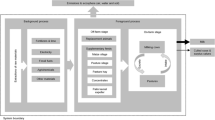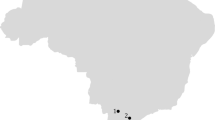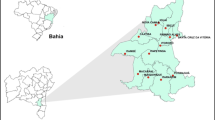Abstract
Purpose
Milk is an important agricultural product due to its ubiquity in the global economy. Brazil is considered one of the largest milk producers in the world. However, milk production systems generate significant emissions of particulate matter (PM), and life cycle assessment (LCA) can be used to manage their environmental impacts. Thus, the aim of this research was to analyze the human health impacts of PM from milk production systems in Brazil and the sensitivity of the LCA results with the application of different characterization models.
Methods
Four milk production systems were analyzed from cradle-to-farm gate, considering 1 kg of fat and protein-corrected milk as a functional unit. The life cycle impact assessment considered five characterization models: Oberschelp et al. (2020), Fantke et al. (2017, 2019), Van Zelm et al. (2016), Tang et al. (2018), and Frischknecht and Jolliet (2016), exploring their levels of regionalization (global, national, and regional factors). Spearman’s correlation analysis was applied to verify the consistency of the milk systems’ ranking according to the characterization model selection.
Results and discussion
Impact results showed high variance due to differences in the inventories, variations in the geographical scopes, list of elementary flows covered by the models, and differences in the characterization factors. Correlation analysis showed lower Spearman’s coefficients for Oberschelp et al. (2020) at the state level and Van Zelm et al. (2016) at the national level, indicating that the regionalized characterization factors present higher variation in the milk systems’ ranking.
Conclusion
Given that the recommendation for this category is the use of regionalized factors, this research concluded that Oberschelp et al. (2020) model was the most suitable for use in the Brazilian milk production systems. For future research, it is recommended similar studies for other impact categories that require regionalized factors and the development of characterization factors by archetypes for primary and secondary substances.




Similar content being viewed by others
Data availability
All data generated or analyzed during this study are included in this published article and its supplementary information files.
References
Bare J (2011) TRACI 2.0: the tool for the reduction and assessment of chemical and other environmental impacts 2.0. Clean Technol Environ Policy 13:687–696. https://doi.org/10.1007/s10098-010-0338-9
Barros MV, Salvador R, Maciel AM, Ferreira MB, de Paula VR, de Francisco AC, Rocha CH, Piekarski CM (2022) An analysis of Brazilian raw cow milk production systems and environmental product declarations of whole milk. J Clean Prod. 367:133067. https://doi.org/10.1016/j.jclepro.2022.133067
Cabral CFS, Elabras Veiga LB, Araújo MG, de Souza SLQ (2020) Environmental life cycle assessment of goat cheese production in Brazil: a path towards sustainability. LWT 129:109550. https://doi.org/10.1016/j.lwt.2020.109550
Cambra-López M, Aarnink AJA, Zhao Y, Calvet S, Torres AG (2010) Airborne particulate matter from livestock production systems: a review of an air pollution problem. Environ Pollut 158:1–17. https://doi.org/10.1016/j.envpol.2009.07.011
Carvalho LS, Willers CD, Soares BB, Nogueira AR, de Almeida Neto JA, Rodrigues LB (2022) Environmental life cycle assessment of cow milk in a conventional semi-intensive Brazilian production system. Environ Sci Pollut Res 29:21259–21274. https://doi.org/10.1007/s11356-021-17317-5
Cavalett O, Chagas MF, Seabra JEA, Bonomi A (2013) Comparative LCA of ethanol versus gasoline in Brazil using different LCIA methods. Int J Life Cycle Assess 18:647–658. https://doi.org/10.1007/s11367-012-0465-0
Chen X, Matthews HS, Griffin WM (2021) Uncertainty caused by life cycle impact assessment methods: case studies in process-based LCI databases. Resour Conserv Recycl 172:105678. https://doi.org/10.1016/j.resconrec.2021.105678
Cherubini E, Franco D, Zanghelini GM, Soares SR (2018) Uncertainty in LCA case study due to allocation approaches and life cycle impact assessment methods. Int J Life Cycle Assess 23:2055–2070. https://doi.org/10.1007/s11367-017-1432-6
CONAB (2022a) Market prices - milk and meat [WWW Document]. Mark. prices - Milk meat. https://sisdep.conab.gov.br/precosiagroweb/
CONAB (2022b) Price of agricultural inputs: biofertilizer [WWW Document]. Price Agric. inputs biofertilizer. https://consultaweb.conab.gov.br/consultas/consultaInsumo.do?method=acaoCarregarConsulta
da Silva DV (2022) Avaliação do Ciclo de Vida e Avaliação dos Serviços Ecossistêmicos: um estudo de caso aplicado a diferentes sistemas de produção de leite. Federal University of São Carlos
Dekker E, Zijp MC, van de Kamp ME, Temme EHM, van Zelm R (2020) A taste of the new ReCiPe for life cycle assessment: consequences of the updated impact assessment method on food product LCAs. Int J Life Cycle Assess 25:2315–2324. https://doi.org/10.1007/s11367-019-01653-3
Dreyer LC, Niemann AL, Hauschild MZ (2003) Comparison of three different LCIA methods: EDIP97, CML2001 and eco-indicator 99. Int J Life Cycle Assess 8:191–200. https://doi.org/10.1065/Ica2003.06.115
Fantke P, Jolliet O, Apte JS, Hodas N, Evans J, Weschler CJ, Stylianou KS, Jantunen M, McKone TE (2017) Characterizing aggregated exposure to primary particulate matter: recommended intake fractions for indoor and outdoor sources. Environ Sci Technol 51:9089–9100. https://doi.org/10.1021/acs.est.7b02589
Fantke P, Jolliet O, Evans JS, Apte JS, Cohen AJ, Hänninen OO, Hurley F, Jantunen MJ, Jerrett M, Levy JI, Loh MM, Marshall JD, Miller BG, Preiss P, Spadaro JV, Tainio M, Tuomisto JT, Weschler CJ, McKone TE (2015) Health effects of fine particulate matter in life cycle impact assessment: findings from the Basel Guidance Workshop. Int J Life Cycle Assess 20:276–288. https://doi.org/10.1007/s11367-014-0822-2
Fantke P, McKone TE, Tainio M, Jolliet O, Apte JS, Stylianou KS, Illner N, Marshall JD, Choma EF, Evans JS (2019) Global effect factors for exposure to fine particulate matter. Environ Sci Technol 53:6855–6868. https://doi.org/10.1021/acs.est.9b01800
FAO (2022) Countries by commodity [WWW Document]. Ctries. by Commod. https://www.fao.org/faostat/en/#rankings/countries_by_commodity
Frischknecht R, Jolliet O (2016) Global guidance for life cycle impact assessment indicators, volume, 1st edn. France, Paris
Giusti G, Almeida GF, Apresentação MJF et al (2022a) Environmental impacts management of grain and sweet maize through life cycle assessment in São Paulo, Brazil. Int J Environ Sci Technol. https://doi.org/10.1007/s13762-022-04418-y
Giusti G, Vieira JGV, de Souza Tadano Y, Silva DAL, Fantke P (2022b) Health effects of particulate matter formation in life cycle impact assessment: critical review and recommendation of models for Brazil. Int J Life Cycle Assess 27:868–884. https://doi.org/10.1007/s11367-022-02068-3
Grout L, Baker MG, French N, Hales S (2020) A review of potential public health impacts associated with the global dairy sector. GeoHealth 4. https://doi.org/10.1029/2019GH000213
Hauschild M, Potting J (2005) Background for spatial differentiation in LCA impact assessment - the EDIP2003 methodology. Environ News
Heijungs R, Dekker E (2022) Meta-comparisons: how to compare methods for LCA? Int J Life Cycle Assess 27:993–1015. https://doi.org/10.1007/s11367-022-02075-4
Hofstetter P (1998) Perspectives in life cycle impact assessment a structured approach to combine models of the technosphere, ecosphere and valuesphere. Swiss Federal Institute of Technology Zurich
Huijbregts MAJ, Steinmann ZJN, Elshout PMF, Stam G, Verones F, Vieira M, Zijp M, Hollander A, van Zelm R (2017) ReCiPe2016: a harmonised life cycle impact assessment method at midpoint and endpoint level. Int J Life Cycle Assess 22:138–147. https://doi.org/10.1007/s11367-016-1246-y
Huijbregts MAJ, Thissen U, Guinée JB, Jager T, Kalf D, Van De Meent D, Ragas AMJ, Wegener Sleeswijk A, Reijnders L (2000) Priority assessment of toxic substances in life cycle assessment. Part I: calculation of toxicity potentials for 181 substances with the nested multi-media fate, exposure and effects model USES-LCA. Chemosphere 41:541–573. https://doi.org/10.1016/S0045-6535(00)00030-8
Humbert S, Marshall JD, Shaked S, Spadaro JV, Nishiokat Y, Preiss P, McKone TE, Horvath A, Jolliet O (2011) Intake fraction for particulate matter: recommendations for life cycle impact assessment LK. Environ. Sci Technol 45:4808. https://libwvu.on.worldcat.org/oclc/5300120733
ISO (2006a) ISO 14040: environmental management - life cycle assessment - principles and framework. Switzerland
ISO (2006b) ISO 14044: environmental management – life cycle assessment –requirements and guidelines. Switzerland
Itsubo N, Inaba A (2012) LIME 2: Outline. JLCA News Lett
JRC (2011) International reference Life Cycle Data system (ILCD) handbook - Recommendations for Life Cycle Impact Assessment in the European context, 1st ed, International Reference Life Cycle Data System (ILCD) Handbook - Recommendations for Life Cycle Impact Assessment in the European context. Publications Office of the European Union, Luxembourg. https://doi.org/10.1017/CBO9781107415324.004
Mostafa E, Nannen C, Henseler J, Diekmann B, Gates R, Buescher W (2016) Physical properties of particulate matter from animal houses—empirical studies to improve emission modelling. Environ Sci Pollut Res 23:12253–12263. https://doi.org/10.1007/s11356-016-6424-8
Mukaka MM (2012) Statistics corner: a guide to appropriate use of correlation coefficient in medical research. Malawi Med J 24:69–71
Murray CJL et al (2020) Global burden of 87 risk factors in 204 countries and territories, 1990–2019: a systematic analysis for the Global Burden of Disease Study 2019. Lancet 396:1223–1249. https://doi.org/10.1016/S0140-6736(20)30752-2
Mutel C, Liao X, Patouillard L, Bare J, Fantke P, Frischknecht R, Hauschild M, Jolliet O, De Souza DM, Laurent A, Pfister S (2019) Overview and recommendations for regionalized life cycle impact assessment. 856–865
Oberschelp C, Pfister S, Hellweg S (2020) Globally regionalized monthly life cycle impact assessment of particulate matter. Environ Sci Technol 54:16028–16038. https://doi.org/10.1021/acs.est.0c05691
Pizzol M, Christensen P, Schmidt J, Thomsen M (2011a) Impacts of “metals” on human health: a comparison between nine different methodologies for life cycle impact assessment (LCIA). J Clean Prod 19:646–656. https://doi.org/10.1016/j.jclepro.2010.05.007
Pizzol M, Christensen P, Schmidt J, Thomsen M (2011b) Eco-toxicological impact of “metals” on the aquatic and terrestrial ecosystem: a comparison between eight different methodologies for life cycle impact assessment (LCIA). J Clean Prod 19:687–698. https://doi.org/10.1016/j.jclepro.2010.12.008
Santos HCM, Maranduba HL, de Almeida Neto JA, Rodrigues LB (2017) Life cycle assessment of cheese production process in a small-sized dairy industry in Brazil. Environ Sci Pollut Res 24:3470–3482. https://doi.org/10.1007/s11356-016-8084-0
Schmidt JH, Dalgaard R (2012) National and farm level carbon footprint of milk—methodology and results for Danish and Swedish milk 2005 at farm gate. Arla Foods, Aarhus, Denmark
Steen BA (1999) A systematic approach to environmental priority strategies in product development (EPS). s. l
Tang L, Nagashima T, Hasegawa K, Ohara T, Sudo K, Itsubo N (2018) Development of human health damage factors for PM2.5 based on a global chemical transport model. Int J Life Cycle Assess 23:2300–2310. https://doi.org/10.1007/s11367-014-0837-8
Turk J, Oven P, Poljanšek I, Lešek A, Knez F, Malovrh Rebec K (2020) Evaluation of an environmental profile comparison for nanocellulose production and supply chain by applying different life cycle assessment methods. J Clean Prod 247:119107. https://doi.org/10.1016/j.jclepro.2019.119107
Ugaya CM, Almeida Neto JA, de Figueiredo MD (2019) Recomendação de modelos de Avaliação de Impacto do Ciclo de Vida para o Contexto Brasileiro, Primeira. ed. Brasília
United Nations (2018) Standard reports - sector profiles [WWW Document]. Sect. profile Rais. Rumin Anim Brazil. http://scp-hat.lifecycleinitiative.org/sector-profiles/
Van Zelm R, Huijbregts MAJ, den Hollander HA, van Jaarsveld HA, Sauter FJ, Struijs J, van Wijnen HJ, van de Meent D (2008) European characterization factors for human health damage of PM10 and ozone in life cycle impact assessment. Atmos Environ 42:441–453. https://doi.org/10.1016/j.atmosenv.2007.09.072
Van Zelm R, Preiss P, van Goethem T, Van Dingenen R, Huijbregts M (2016) Regionalized life cycle impact assessment of air pollution on the global scale: damage to human health and vegetation. Atmos Environ 134:129–137. https://doi.org/10.1016/j.atmosenv.2016.03.044
Wang Z, Osseweijer P, Posada JA (2020) Human health impacts of aviation biofuel production: exploring the application of different life cycle impact assessment (LCIA) methods for biofuel supply chains. Processes 8:158. https://doi.org/10.3390/pr8020158
WHO (2018) Ambient (outdoor) air pollution [WWW Document]. https://www.who.int/news-room/fact-sheets/detail/ambient-(outdoor)-air-quality-and-health
Wyer KE, Kelleghan DB, Blanes-Vidal V, Schauberger G, Curran TP (2022) Ammonia emissions from agriculture and their contribution to fine particulate matter: a review of implications for human health. J Environ Manage 323:116285. https://doi.org/10.1016/j.jenvman.2022.116285
Yang X (2010) Physical, chemical and biological properties of airborne particles emitted from animal confinement buildings. University of Illinois at Urbana-Champaign
Funding
This work was supported by the “Fundação de Amparo à Pesquisa do Estado de São Paulo” (FAPESP, grant numbers 2021/06685–1 and 2022/06039–5), the Coordenação de Aperfeiçoamento de Pessoal de Nível Superior—Brasil (CAPES) (Finance Code 001, grant numbers 88887.498791/2020–00 and 88887.703365/2022–00), the “Conselho Nacional de Desenvolvimento Científico e Tecnológico” (CNPq, grant number 302722/2019–0) and the Research Network on Life Cycle Impact Assessment (RAICV).
Author information
Authors and Affiliations
Corresponding author
Ethics declarations
Conflict of interest
The authors declare no competing interests.
Additional information
Communicated by Ian Vázquez-Rowe.
Publisher's Note
Springer Nature remains neutral with regard to jurisdictional claims in published maps and institutional affiliations.
Supplementary Information
Below is the link to the electronic supplementary material.
Rights and permissions
Springer Nature or its licensor (e.g. a society or other partner) holds exclusive rights to this article under a publishing agreement with the author(s) or other rightsholder(s); author self-archiving of the accepted manuscript version of this article is solely governed by the terms of such publishing agreement and applicable law.
About this article
Cite this article
Giusti, G., da Silva, D.V., Albino, A.C.G. et al. Human health impacts of particulate matter emitted from different milk production systems in Brazil: a regionalized LCA sensitivity analysis. Int J Life Cycle Assess 28, 1466–1480 (2023). https://doi.org/10.1007/s11367-023-02184-8
Received:
Accepted:
Published:
Issue Date:
DOI: https://doi.org/10.1007/s11367-023-02184-8




